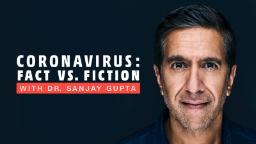(CNN) — Our experience in airports and airplanes changed dramatically after 9/11. And experts now expect a similar transformation as a result of the pandemic. CNN Chief Medical Correspondent Dr. Sanjay Gupta talks to Dr. Henry Wu, the director of the Emory TravelWell Center and other travel experts about what to expect the next time you get on a plane.
You can listen on your favorite podcast app or read the transcript below.
Richard Quest, anchor, CNN’s “Quest Means Business”: Airlines are ramping up other precautions. On JetBlue, Air Canada, Korean and Lufthansa, masks will be mandatory for the duration of flights.
James Fallows, staff writer, “The Atlantic”: For the foreseeable future, they don’t expect a return to anything like normal. And when there is a normal, they say it will be after a vaccine.
Gary Kelly, CEO, Southwest Airlines: If we get to the point where we’re in the fall of 2020 and things are still as poor as they are, there’s no choice. We’ll lose $900 million in cash in the month of April. And obviously, that’s just not sustainable.
Dr. Sanjay Gupta: Next time you go to the airport, you’re probably likely to see mandatory face coverings, temperature checks and fewer routes — these are only some of the measures airlines are now implementing as the world slowly reopens.
And they’re not the only changes that this industry now has to face — as you might imagine, air travel has been hit especially hard by this pandemic, as people all over the world have been told to stay at home.
So far, a federal bailout for the airline industry has prevented layoffs, but executives have estimated that once the prohibition lifts, up to a third of all the sector’s jobs could disappear.
I normally travel a lot for my job, so I wanted to find out what this all means for the future. Is it safe to travel? Should you be taking that cheap deal to fly to Miami? Will airports ever go back to normal? I’m gonna talk about all of that in this episode.
When we first began this podcast, i talked about travel safety all the way back in the fourth episode with Dr. Henry Wu. He’s the director of the Emory TravelWell center. So I decided to call him again to talk about all the changes in travel that have happened just over the last couple of months — and all the changes he thinks will still happen in the future.
Gupta: Last time we had you on the show was back in March. We were still talking at that point about whether people should postpone their spring break travel plans. What do you think has been the most surprising change to travel since we last spoke?
Dr. Henry Wu, director, Emory TravelWell Center: Well, so much has changed since March. Obviously travel has dropped down significantly due to not only the State Department and CDC [Centers for Disease Control and Prevention] travel advisories, but also just a greater recognition of the risk of travel, not just internationally, but within the U.S.
Gupta: I think people are going to be surprised when they maybe first travel again after all this. That airports are going to look different. What have you heard?
Wu: I think the rapid testing of passengers is certainly interesting.
I do think in the longer term, my hope would be an effective vaccine. Vaccine requirements for travel is not new. As you know, you do need things like yellow fever vaccine or polio vaccine for certain trips.
And that would be my hope for the future. A vaccine that could be used and then recorded in the travel documents like your yellow card there for immunizations.
Gupta: And it is worth reminding people that as strange as this may seem, there are many countries around the world that do require some proof of vaccination against infections that they are worried about, such as yellow fever, particularly in some countries in Africa.
Now, when you look forward, what are the indicators that you would look for in terms of knowing that it might now be safe to travel again?
Wu: So, I’d like to see the number of new cases dropping to very low levels in Europe and in North America and South America to levels that we’ve seen some countries in Asia managed to bring it down to.
I do think when that’s clear that new cases are low in much of the world, I certainly would agree that the risk to travelers, both in getting infected, and also being in a country with a health system that is overwhelmed, is going to be minimized. So, you know, obviously part of this depends on having good data in terms of being able to diagnose.
Gupta: Will you be jumping on any planes this summer?
Wu: I would if I certainly had an important issue, I have elderly parents who live far away. And if I needed to see them, I certainly would not hesitate to do so. I am obviously very familiar with the recommendations on personal protection, and I am also very confident that the major airlines are taking a lot of proactive steps to protect their passengers.
So, if we’re talking about the summer, certainly I think again, for necessary travel, it can be done with most of the risks mitigated.
Gupta: Well, I appreciate your time, Dr. Wu. I know these are strange and unsettling times for everybody. And your hair is a bit longer, looking at you on Zoom, than the last time I saw you.
Wu: Absolutely. Hahaha.
Gupta: So how are you feeling about traveling? What do you think needs to happen to convince people to travel again? We decided to ask Erika Richter from the American Society of Travel Advisors.
Erika Richter, senior director of communications, the American Society of Travel Advisors: The future of travel will really depend on establishing confidence with the traveling public. And that is enhanced cleanliness and hygiene standards.
Gupta: Aside from requiring face masks, which you’re simply going to see more of, some airlines are also reducing food and beverage services in flight.
Frontier Airlines is the first US carrier to announce plans to implement temperature checks. That’s gonna start in June. Others have said they are limiting seat selection options to allow more distance between passengers.
Richter: There’s been a lot of discussion about the middle seat. And the reality is that airlines and their business model depend on a load factor of airplanes.
So the rule of economics basically says that if you take out 30 percent of the seats from that business model then fares may have to go up and that might not be beneficial for passengers or airlines.
Gupta: Outside the United Sates, different countries have also been trying different things. New Zealand and Australia have committed to creating a “travel bubble” that allows visits between the two countries without quarantine — once it’s safe to do so.
China has begun allowing domestic travel, although its borders are still shut to most foreigners. Thailand is considering special tourism resorts that also double as quarantine zones.
Here’s Erika Richter again.
Richter: It’s not going to look the same for everybody. And that’s part of what creates this uncertainty, is that every traveler’s situation is going to look different. And what they will be expecting will also be different.
And so that’s why we’re saying, “OK, we need to have these standard procedures in place and they need to be clear,” so that we can communicate with our clients what they are going to expect when they get to the airport. And that is yet to be seen.
Gupta: Now we don’t know what these standards are yet, and we don’t know how permanent they could be.
Richter: If you think about 9/11 and how we pivoted after 9/11 from the airport screening process all the way through boarding the plane. You know, those enhanced screening measures at the airports eventually became faster and more efficient. Taking the shoes off, taking the belt off, 3 ounce bottles, things like that.
And we know that there’s going to be some changes. This is where we need the government to step in with a standardized process.
Gupta: Aside from the changes we can see happening now, there will likely be more in the future.
For some experts, that means we’re gonna have to rely on technology for touchless travel. And that might mean high-tech solutions. Here’s Andrea Serra from the World Economic Forum. Even before the pandemic, she was already working on a digital identity project called the [Known Travelers Digital Identity] program.
Andrea Serra, project lead, Known Travelers Digital Identityt, World Economic Forum: What Covid has brought to the spotlight is the fact that the future of travel now needs to be touchless, contactless and seamless. Right? And second, it’s brought to light the fact that we now need to embed health as a key component of the end-to-end journey.
Gupta: For Andrea, the future of travel is touchless and paperless. Truth is, we already have some of it in place now — our boarding passes are already on our phones, and we already check in online.
Serra: You would perhaps walk into a check-in counter that has facial recognition facilitated and through that way you would obtain a bag tag.
And there might also be a feature to avoid queuing at the gate. Right, because at the gate is also a point where a lot of people gather. I mean, airlines have thought about this for a while now. I know Delta had a — way back when — a program for digital queueing. So there might be a way for you to be in the queue in your phone, and you’re called whenever it’s your turn, etc.
Gupta: Travel, like so many other industries affected by the pandemic, is still in flux. But a lot of experts do agree that we will adapt. We’ve done it in other circumstances before, and we will do it again. I’m convinced of that.
We’ll be back tomorrow. Thanks for listening.
















































